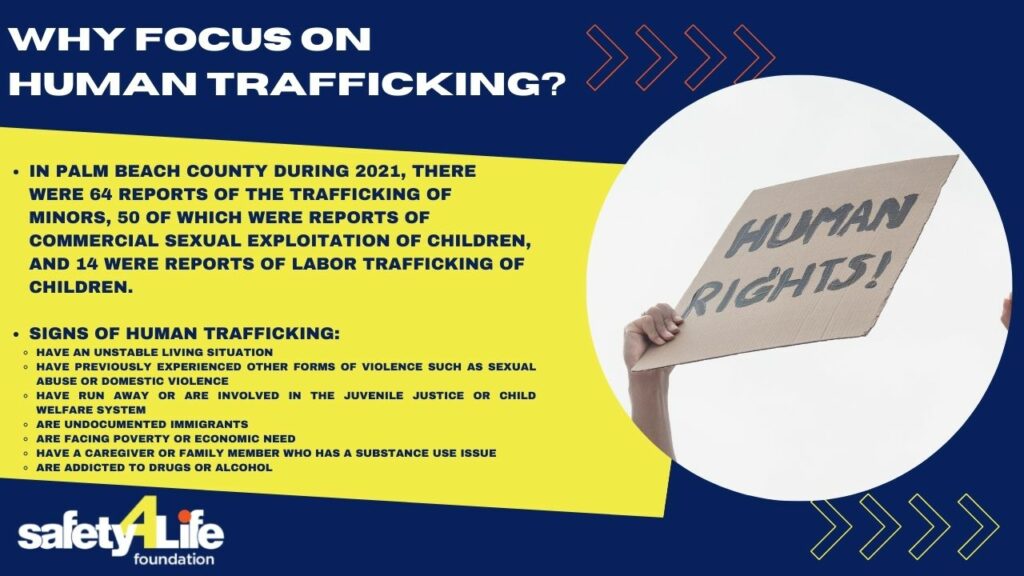Human Trafficking
Welcome to the Safety 4 Life Human Trafficking program, dedicated to raising awareness, educating individuals, and mobilizing action to combat human trafficking in our communities. Human trafficking is a pervasive and insidious crime that affects millions of people worldwide, including vulnerable individuals and marginalized communities. Our program is committed to equipping individuals with the knowledge, skills, and resources they need to recognize the signs of human trafficking, support survivors, and advocate for systemic change. Through educational initiatives, outreach efforts, and collaborative partnerships, we strive to empower communities to take a stand against human trafficking and create a safer and more just society for all. Join us in our mission to end human trafficking and protect the rights and dignity of every individual.
Impact Statistics


Safety 4 Life puts a focus on human trafficking awareness so that everyone is aware of the dangers of possible traffickers, while also knowing the signs of someone who may be being trafficked.
Safety 4 Life Human Trafficking Program Highlights
Education and Awareness Campaigns: Engage in comprehensive educational initiatives and awareness campaigns to increase understanding of human trafficking dynamics, including its prevalence, root causes, and impact on individuals and communities.
Training and Workshops: Participate in interactive training sessions and workshops designed to equip individuals with the knowledge and skills to recognize the signs of human trafficking, respond effectively to suspected cases, and support survivors with compassion and empathy
Collaborative Partnerships: Foster collaborative partnerships with law enforcement agencies, non-profit organizations, government agencies, and community stakeholders to enhance coordination, share resources, and leverage collective expertise in the fight against human trafficking.
Safety 4 Life is empowering individuals to make informed decisions behind the wheel and is dedicated to creating safer roads and saving lives
How to Get Involved
- Donate: Support Safety 4 Life’s mission by making a donation to fund our educational programs and resources.
- Volunteer: Contribute your time and skills by volunteering at events, workshops, or outreach activities.
- Request Presentations: Bring Safety 4 Life to your school or community organization by requesting our programs and presentations to educate others on safety topics.
- Attend Events: Participate in Safety 4 Life events and activities to learn more about safety and connect with like-minded individuals.
- Become an Ambassador: Get involved in our foundation and become a key part of spreading Safety 4 Life’s message
- Partner with Us: Explore partnership opportunities with Safety 4 Life to collaborate on projects and amplify our impact together.
FAQ's
Human trafficking involves the exploitation of individuals for forced labor, sexual exploitation, or other forms of exploitation. It is a prevalent and widespread crime that affects millions of people worldwide, including individuals in our own communities.
Common signs of human trafficking include individuals appearing malnourished or showing signs of physical abuse, being unable to speak for themselves or seeming to be under the control of someone else, and exhibiting signs of fear, anxiety, or depression. It’s essential to be aware of these signs and report any suspicions to authorities.
You can protect yourself and your peers from human trafficking by staying informed about the issue, being cautious of online interactions and relationships, trusting your instincts, and seeking help or reporting any suspicious activity to trusted adults or authorities.
There are various resources available for survivors of human trafficking, including shelters, hotlines, counseling services, legal assistance, and support groups. Safety 4 Life can provide information and referrals to relevant resources for survivors seeking assistance and support.
You can get involved in raising awareness and combating human trafficking by participating in educational initiatives, volunteering with organizations that work to prevent human trafficking, advocating for policy reforms, and supporting survivors through fundraising and support initiatives. Safety 4 Life offers opportunities for students to engage in awareness campaigns and advocacy efforts to make a difference in the fight against human trafficking.
